By Jeffrey A. Rendall; Photos By Jeffrey A. Rendall and Dave Vier
EASTON, MD – Philanthropy takes many forms, and we’ve heard and seen it play out in a multitude of ways. As an example, our jaws dropped recently when McDonald’s heiress Joan Kroc left a billion dollars to the Salvation Army – and we’ve benefited locally for many years with John D. Rockefeller’s lasting philanthropic legacy that is Colonial Williamsburg.
It shouldn’t be surprising then, when someone donates a plot of land to a County that she loved, for the purpose of promoting a game which was the inspiration of her husband. It’s a treasured gift, even when that plot of land contains the word ‘hog.’
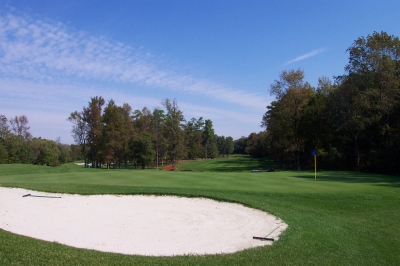 |
| Muni course or private club? The par four 16th hole, along with most of Hog Neck's layout, blurs the distinction. |
Such is the case for Hog Neck Golf Course in Talbot County, Maryland (along Rt. 50 on Maryland’s eastern shore). The Lindsay Ervin designed golf course opened in 1976, a gift from Mrs. W. Alton ‘Nettie’ Jones to Talbot County, and it’s received much attention and acclaim ever since.
Mark Herrmann, Hog Neck’s Manager, tells the story: “Mrs. Jones lived in the area at that time, and wanted to give something back to the community. Her husband had been Chairman of Cities Services Company (now CITGO), and when he died, she owned many pieces of land in the area. One of those farms was Hog Neck Farm, which she thought would make a great place for a golf course.”
Despite its rather odd sounding name, Mrs. Jones’ wisdom was right-on, though no one seems to know why the land contained the unusual moniker. The property was about half open space and half wooded (including a tree farm), so variety was already built in to any potential golf layout.
“Mrs. Jones did more than just build a golf course – the ice skating rink across the highway was also part of Hog Neck farm. People always ask me why it’s called ‘Hog Neck,’ and I’ve talked with hundreds of people native to the area. No one seems to know the origin of it, and it dates back to the early 1700’s,” Herrmann said.
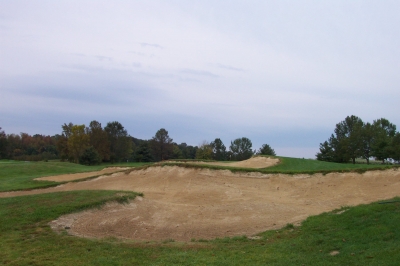 |
| Hog Neck's fairway sand bunkers blend seamlessly with the land. Here, the par four 2nd hole. |
It’s a good thing that Mrs. Jones was of the mind and generous nature to bring golf to the area, since at that time, there weren’t many destination choices to play in the greater DC area.
“I think we were one of the first, if not the first ‘destination’ golf course in these parts,” Herrmann (who’s been at Hog Neck since one month after its opening) commented. “Even though we’re a County owned, public golf course, we’ve gathered quite a reputation for providing an upscale golf experience. Back then, if you didn’t belong to a club, there just weren’t any places that you’d actually travel to play golf, with good course conditions, a nice golf layout and great challenge.”
“So people would stop by when traveling to the beach, or just make a day trip to play at a quality place other than their own club. They would come over here to the eastern shore, play at Hog Neck, then maybe head down to St. Michaels for some shopping,” Herrmann said.
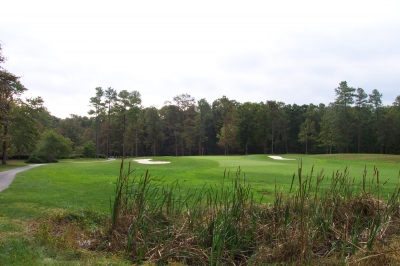 |
| At 474 yards, the par four 12th hole plays more like a five. These wetlands hint at the difficulty. |
In order to make a go of it as a public golf course, they had to make Hog Neck pretty special, since the demographics of the area wouldn’t necessarily support an upscale facility – or any facility, for that matter. Herrmann says you usually need eighty to a hundred-thousand people within a twenty mile radius to make a club like his work, but even today there are only thirty-thousand in all of Talbot County.
In other words, they need to draw from outside the area.
No problem, says Herrmann – that was the plan all along: “Since Mrs. Jones donated the land and paid to build the course, we had to maintain and care for it. There was an important legacy to uphold here, so attracting the people was just part of keeping Hog Neck up to standards.”
Keeping up those standards, as well as modernizing the course, were immediate concerns of Herrmann and the Hog Neck staff since the late ‘90s. The course was built in the early 70’s using the land’s existing soil (which wasn’t so good in spots), and as a result, the greens started showing signs of wear and tear, beyond what an upscale golf facility would offer. Something had to be done, and was.
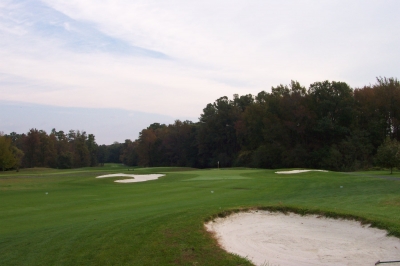 |
| You can club down off the tee of the par four 5th hole, but you'll still need to put it in the fairway to attack this green. |
“We realized that we had a situation in the late 90’s where we had to redo the greens,” said Herrmann. “In today’s competitive golf environment, with most courses keeping their greens at much faster speeds than in the old days, we couldn’t keep up with the putting surfaces that we had. We’d basically lose the turf from July to September every year, and the playing conditions weren’t close to where we wanted them to be – and we suffered from a business standpoint because of it.”
The dreaded Poa Annua was the cause of it. You hear about Poa as mostly a west coast phenomenon, but it’s everywhere, according to Herrmann. Poa won’t tolerate the Mid-Atlantic summer heat or being mowed everyday, so the choice of the relatively new L93 bentgrass (getting rid of the Poa in the process) brings Hog Neck’s putting surfaces up to date, placing that last piece in the puzzle necessary to push the course back up into the ‘best in the area’ category.
They initially were only going to redo three greens at a time, but after finishing the first threesome in 2000, a decision was made to shut down the whole facility to complete the rest, en masse. As a result, Hog Neck was closed from August of 2002 to May 1st of last year (2003).
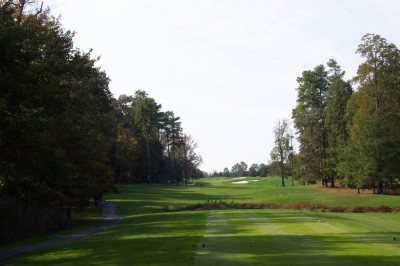 |
| The view from the tee of the par four 16th -- missing right or left is not a good option. |
The greenside bunkers were also redone so they drain much more effectively – which after last season’s rainy weather, is no small consideration. When we saw the course last October (2003), it was in very fine condition, without the slightest hint at how young the greens were. A few of the fairways (especially on the back nine) were a bit soggy, but in the wake of Hurricane Isabel, that’s to be expected.
As you’d gather based on the discussion above, playing Hog Neck is quite a treat. When touring the layout, you’ll have a hard time believing it’s essentially a ‘muni,’ being County owned and operated. But from the back tees, it’s also one of the better tests in the area, despite only packing a slope rating of 131 and rating of 73.7.
Herrmann says that’s because it was built in the old days: “Our course is a good, traditional, old-style course in terms of architecture. It’s not ‘penal’ as we call it today, with all the hazards in front of you, with wetlands and the way they have to avoid disturbing certain areas. There are virtually no forced carries on this course – all your trouble is lateral, parallel to the fairways.”
“The back nine’s one of the toughest I’ve ever played, and I’ve been fortunate enough to play a lot of courses in the top 10 or 20 in the world. Those courses are difficult, too, but I still think we’ve got one of the best I’ve ever seen,” Herrmann added.
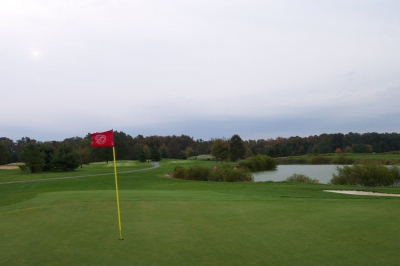 |
| Looking back from the green of the par three 3rd hole. |
The front side contrasts the back – it’s fairly wide open, though you’ll contend with lakes and glades instead of timber. Like all courses, keeping it in the fairway’s pretty important, and don’t leave the big stick at home, either. If you play the 3655 yard back nine (the front measures 3394) from the tips, you’ll need to be very long, and straight.
The greens are also good sized – 7000-7500 square feet, which provides much to shoot at. Herrmann says the big greens allow for seven cup locations, which helps keep the ‘new’ Hog Neck greens in good shape.
Hole highlights include the par fives on the front side, numbers four and nine. The fourth hole, 503 yards from the tips, is the epitome of risk-reward – not only is it short, it often plays with the prevailing wind, according to Herrmann. The tricky part’s the tee shot, with bunkers jutting in from the right and a lake lining the left side. If you choose driver, you’ll have to place it in the thirty-yard wide fairway to have a chance at the green in two.
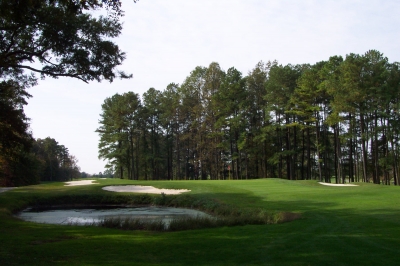 |
| Sunlight and shadow reveal and hide the challenges at the par four 15th hole. |
The ninth hole is slightly longer at 546 yards, but the landing area’s wider. Still, if you miss right you’re in the water, and too far left you’ll have tree trouble. One note, if you choose to lay-up, double check the proper yardage as a stream crosses the fairway just past the landing area. For potential second/third shots, you’ll need to avoid bunkers fronting the green, with just a sliver of fairway to run-it-up.
The back nine, as Herrmann indicated above, is a notch tougher than the outward nine. Particularly challenging is a five hole stretch beginning with the 12th hole – a 474 yard par four. The day we played it was into the wind with fairly wet conditions. Herrmann says you’ve got to be a masochist to play from the tips (even if you’re a very good player), and this hole proved that point. Conceding par will probably guarantee a bogey if you play it as a three-shot hole, but what fun is that?
The yardages on the ensuing links – 218 (par three), 604 (par five), 436 and 439 (par fours) will give you all you’ve got in terms of length and difficulty. The par five 14th hole seems like it goes on forever, though it is fairly wide. Herrmann adds, “for twelve through seventeen, you’re always going to have a tough approach shot, regardless of whether it’s a par three, four or five. You’ll wear out a two or three-iron or three-wood on those holes.” That sums it up well.
The par three 17th is probably Hog Neck’s signature hole because of a beautiful decorative bridge crossing a stream about three-quarters of the way to the green (209 yards). The putting surface is also well guarded by sand, so choose clubs wisely.
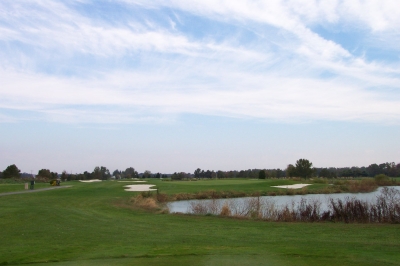 |
| Take good measure of the wind at the wide-open par three 7th hole. |
Hog Neck is one of those rare gems that you seem to pass by on the road to somewhere else, wondering half the time whether it’s worth the trouble to stop sometime and check it out. It’s only about 40 miles from downtown Washington (over the Bay Bridge), and all it needs is the notoriety to ensure its deserved position on your ‘must play’ lists.
Philanthropy has its place, and for Hog Neck Golf Course, that place is well occupied.
Note: Hog Neck also has a nine-hole executive course, from 1667 – 2172 yards, par 32.
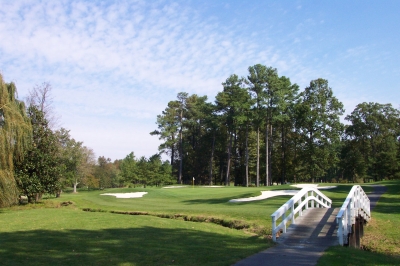 |
| There's even a touch of class at Hog Neck. It's got to be one of the best bargains in the Mid-Atlantic. Here, the par three 17th hole. |
Where To Stay
On our visit, we stayed at the Harbour Inn, Marina and Spa in nearby St. Michaels. As the name implies, it’s right on the St. Michaels marina, and we could literally walk out the sliding glass door from our room and be at the Marina.
The Harbour Inn offers several different types of accommodations (46 rooms total), from traditional hotel rooms (called ‘Guest Quarters’) to luxurious suites including wet bar, balcony and Jacuzzi tub. Ours was a one bedroom suite complete with two queen size beds and a spacious sitting room and a wet bar area that included a refrigerator. We’ve found on our travels that having access to a refrigerator is a valuable convenience, indeed!
Amenities include harbourside pool, whirlpool and exercise room, as well as restaurant and tavern.
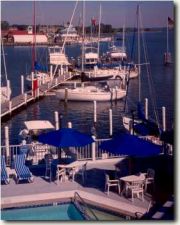 |
| Marina views in abundance at the Harbour Inn. |
New amenities include a Spa (opening April, 2004). We didn’t get to try it, but it looks spectacular!
The staff was courteous, the location very convenient to the town and the views were outstanding. No better place to enjoy the charming ambiance that is St. Michaels.
For more information on the Harbour Inn’s offerings and reservations, try their website: www.Harbourinn.com, or call (800) 955-9001.
Details:
Hog Neck Golf Course
Phone: (410) 822-6079; (800) 280-1790
Website: www.hogneck.com
Course Designer: Lindsay Ervin
Golf Course Manager: Mark Herrmann, PGA
Golf Professional: Mike Kaminskas, PGA
Superintendent: David Burkhart, GCSAA
Tees/Yardage/Slope/Rating
Gold 7049/131 73.7
Blue 6474/128 71.0
White 5941/122 68.5
Red 5434/125 71.3
Rates:
After May 1st: M-Th: $55. Fri-Sun, Holidays: $65. Rates include cart.
Twilight rates available – starting time dependent on the time of year.
Unrestricted walking is permitted, but there isn’t a separate rate.
Range balls: $3 and $5.
Note: There will be a special rate during April on weekdays – call the club for details.
| Related Links | Comments on this article? | |
|
Maryland National Golf Club Hollow Creek Golf Club Rocky Gap Resort PB Dye Golf Club in Ijamsville Whiskey Creek Golf Club |
E-mail Jeff Rendall, Editor: jrendall@golftheunitedstates.com |












